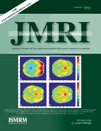New respiratory gating technique for whole heart cine imaging: Integration of a navigator slice in steady state free precession sequences
Abstract
Purpose:
To evaluate the performance of a slice navigator sequence integrated into a b-SSFP sequence for obtaining real time respiratory self-gated whole heart cine imaging.
Materials and Methods:
In this work, we present a novel and robust approach for respiratory motion detection by integrating a slice navigator sequence into a balanced steady state free precession (b-SSFP) sequence, while maintaining the steady state. The slice navigator sequence is integrated into consecutive repetition times (TRs) of a b-SSFP sequence to excite and read out a navigator slice. We performed several phantom experiments to test the performance of the slice navigator sequence. Additionally, the method was evaluated in five volunteers and compared with breathing signals obtained from conventional pencil beam navigator sequence. Finally, the navigator slice was used to obtain whole heart MR cine images.
Results:
The breathing signals detected by the proposed method showed an excellent agreement with those obtained from pencil beam navigators. Moreover, the technique was capable of removing respiratory motion artifacts with minimal distortion of the steady state. Image quality comparison showed a statistical significant improvement from a quality score of 2.1 obtained by the nonrespiratory gated images, compared to a quality score of 3.4 obtained by the respiratory gated images.
Conclusion:
This novel method represents a robust approach to estimate breathing motion during SSFP imaging. The technique was successfully applied to acquire whole heart artifact-free cine images. J. Magn. Reson. Imaging 2011;. © 2011 Wiley-Liss, Inc.




